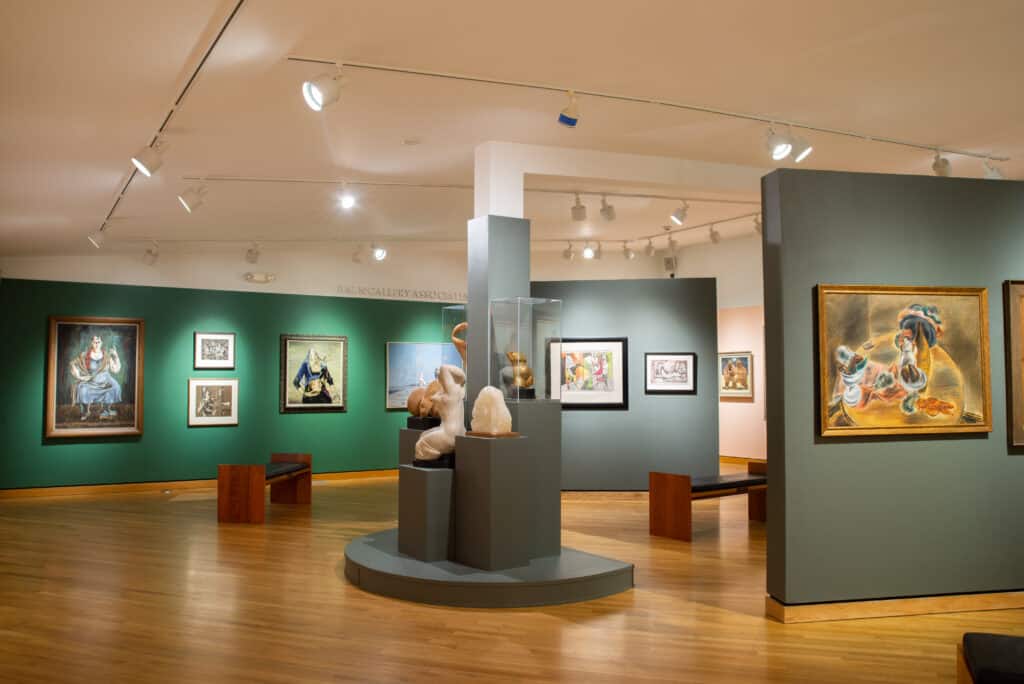PORTLAND PRESS HERALD
June 25, 2023
By Jorge S. Arango

At left, Walt Kuhn, “Sleeping Girl, 1922; in middle, Reginald March, “Irviring Place Burlesque, 1930, top, and Walt Kuhn, “Clown with Dogs,” bottom; at right, Charles Augustus “Gus” Mager, “Cave Man,” circa 1930. Photo courtesy of Ogunquit Museum of American Art
In case you hadn’t noticed, museums across the land have been striving to be more inclusive on many levels – luring new audiences by boosting programming for youth, hosting events for younger collectors, ramping up lecture series and other programming and, not least of all, reinterpreting their collections.
But it really took recent sociopolitical movements like MeToo, Black Lives Matter, Stop AAPI Hate and the same-sex marriage and trans movements – as well as a whole lot of protest art that laid the ground for them – to shake the consciousness of museums out of its fustiness and into real action.
The Farnsworth Art Museum maximized the occasion of its 75th anniversary to dive deep into its holdings and embark on a program of acquisitions to better represent the infinite diversity of human artistic expression in the state. The Ogunquit Museum of American Art also marks its 70th with “Networks of Modernism: 1898-1968” (through Nov. 12) and, most recently, the Portland Museum of Art opened “Passages in American Art” (through at least 2026).
At the Ogunquit, curator Devon Zimmerman reorganized the permanent collection, identifying Ogunquit as one hub – among others such as Taos, Monhegan Island, Provincetown, New York and Paris – through which various artists and genres circulated and cross-pollinated. Zimmerman parsed the permanent collection, supplementing it with works long hidden in storage and a few borrowed ones, according to several social trends that informed painting and sculpture from the turn of the 20th century until the twilight of the 1960s.
To distinguish amongst the various rubrics, walls are painted pink, green or gray, shades pulled from one of the museum’s most famous holdings, Walt Kuhn’s “Sleeping Girl” of 1922. I’m not usually a fan of colored walls. But I must admit, here they work splendidly. Pink, in particular, makes certain canvases radiate with new life.

Rockwell Kent’s 1919 “Alaskan Sunrise,” flanked by Marsden Hartley’s “Mt. Katahdin Winter” of 1939-40 and “Mountains, New Mexico” of 1919. Photo courtesy of Ogunquit Museum of American Art
The most stunning example is Rockwell Kent’s 1919 “Alaskan Sunrise.” The glacial peaks in the distance, tinted rose by the dawn, veritably float off the wall, as do the fleshy shades in the Marsden Hartley paintings flanking it (“Mt. Katahdin, Winter” of 1939-40 and “Mountains, New Mexico” of 1919). On the perpendicular pink wall, the same occurs with Rudolph Dirks’s 1919 “Mountain Pool” – a revelation from the archives displaying a congregation of female nudes who, in Dirks’s squiggly brushstrokes, barely adhere to figuration as they seem to become part of the thickly impastoed sylvan landscape.
All the aforementioned works reside in a section called “Against the Modern,” which focuses on locales artists sought out to escape the grime and grit of the cities, so they could paint nature.
The section “In the Shadows of Skyscrapers” is the flip side of that coin. Particularly magnificent here is Reginald Marsh’s “The Bowery Drunks,” a double painting of the same scene. Many elements are identical, but the verso represents Marsh’s first attempt, made clear by a newspaper in the foreground bearing the 1947 headline from the New York Daily News (where Marsh worked as illustrator): “Doris Duke Here Without Mate.” The 1948 version’s tabloid carries the headline, “Brooklyn Youth Slain by Arabs.” The headlines alone speak volumes about attitudes both persistent (media fascination with celebrity culture) and – hopefully – outdated (prejudices towards people of Middle Eastern descent).
The “Working on It” section gathers paintings about American labor, placing Kuhn’s “Sleeping Girl” in a context we mightn’t have considered. The subject is a vaudeville dancer. She has fallen asleep in her chair, head on the adjacent table, because she is exhausted from late-night entertaining. Painted in 1922, it would of course have been about the thankless schedule she had to keep to make ends meet. Yet this had never occurred to me. It’s an excellent example of how new contexts expand our view of even familiar works.
The most unusual section is “Seeing Beyond.” It’s fascinating not only because it highlights the emergence of American Surrealism in the 1920s (following Freudian theories about the unconscious) as well as Eastern mysticism and occult practices among American creatives. It also features a surprising coterie of gay painters as well as one of the exhibition’s two African American painters: the little-known Hughie Lee-Smith, who achieved notoriety for surreal scenes of alienated human relationships.
Zimmerman’s wall plaque for this section explains, “Surrealist strategies also provided marginalized artists opportunities to more safely express their identity and critique social norms.” Here we get works like Paul Cadmus’ slightly eerie 1959 “Mobile,” Channing Hare’s 1945 “Portrait of a Woman” (she holds her head in her lap), and Stephen Hopkins Hensel’s 1948 “Séance,” a painting that leaves you wondering whether you’re looking at a drag queen or a woman (Hare “adopted” Hensel – one way gay people skirted anti-sodomy laws).
The central section continues some themes (i.e.: works by gay painters Marsden Hartley, Mark Tobey and, on loan from Jay DeMartine, Carl Sprinchorn), but adds in sculpture (William Muir’s “Danseuse Comique” is especially beautiful), and some outliers (Lynn Drexler, on loan from Berry Campbell, and Romare Bearden). You will look at works you’ve seen often in a whole new light.
An excellent concurrent exhibition, “Shifting Sands: Beaches, Bathers and Modern Maine Art,” examines the evolution of our ideas about the beach through similar themes of labor, race, sexuality and so on. And it all looks terrifically immediate with the new uninterrupted window onto Perkins Cove installed last year.



